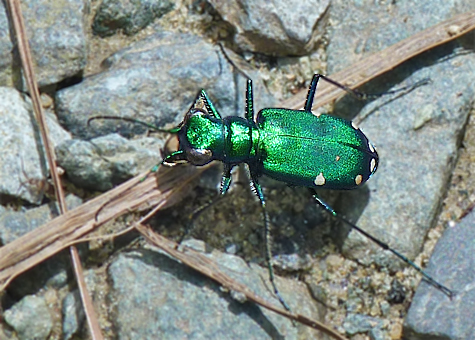
What is a Cicindela sexguttata? It’s a Six-spotted Tiger Beetle and if you’ve followed this Journal for the past several years you’d know that I usually start seeing them along the paths here at the Museum in March, and certainly by April. This is the latest sighting (5/8) of this emerald hued tiger beetle since I’ve been here at the Museum. I saw one at my home a few weeks back, but just one, a fleeting glance at one as it landed on my back porch and just as quickly flew off.
The six-spotted tiger beetle gets its name from the six white spots on the edge of the elytra, the hard forewings of the beetle which serve as a covering for its flight wings. Not all six-spotted tiger beetles have such noticeable white spots as the one in the photo (some have even more white than the one pictured) but you can be fairly certain that you’re seeing one of these beetles if you’re hiking along your favorite trail in the spring and a 1/2 inch long, bright green beetle lands in front of you on the path. It’s an early season tiger beetle and the only bright green one in our area, although, in the right light the elytra may appear blue.
All tiger beetle species are predators, most of them run and fly swiftly. Their prey consists of everything from ants to moths to spiders. The six-spotted’s swiftness and large white mandibles make it a very capable predator. If you happen to see one on the path, approach it slowly and watch it carefully, you may see it capture prey and devour it right there on the spot!
Have fun.
What a Gem!!
I have a photo of the Six-spotted Tiger Beetle I shot last spring. I am fascinated with beetles and this one is a beauty.
I sure enjoy your blog, the photos and great information Greg!
Thanks, Judy.
There’s another tiger beetle that I used to see on one of the service roads here at the Museum, Eastern Red-bellied Tiger Beetle. The service road had been clay but has now been covered with gravel and no longer supports the beetle, they used to burrow into the clay but can no longer do that due to the gravel. However, they are common in our area wherever there is an unsurfaced clay road or foot path. As you probably know, we have a lot of clay hereabouts. Red-bellieds are not as colorful as the six-spotted but just as interesting.
Thanks again.